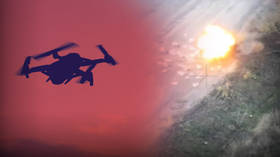Behind the headlines, Russia’s advance in Donbass reveals shifting tactics, collapsing defenses, and the stakes of 2025’s decisive fight
The Donbass town of Pokrovsk (known in Russia as Krasnoarmeysk) has found itself at the center of attention in recent days. In many ways, the Russian advance in this strategic stronghold appears to be following a familiar pattern: Ukraine denies there’s a crisis, holds on too long, attempts futile counterattacks instead of executing a retreat and ultimately gives way with tremendous losses.
But similarities aside, what is happening here comes at a pivotal time and may well determine how the next phase of the war shapes up.
The Kiev regime is, as is its unfailing tendency, attempting to downplay the crisis – although, as we will see below, its actions say otherwise. Mikhail Podoliak, an adviser to Vladimir Zelensky, insists there’s no encirclement, claiming instead that Ukrainian special units are “clearing out infiltrating Russian troops.”
Zelensky himself claims that Moscow is exploiting the “Pokrovsk narrative” to project an image of success on the battlefield.
Russian President Vladimir Putin, meanwhile, says the enemy is already trapped in the cities of Kupiansk and, using the Russian name, Krasnoarmeysk (Pokrovsk). Ukrainian attempts at obfuscation aside, many Western media reports paint a similar picture.
If it’s clear enough to most how things will play out militarily in Pokrovsk, many commentators do not yet see these events for their likely true significance: the decisive fight of 2025. Why does Pokrovsk matter so much, how did this situation unfold, and what lies ahead?
The importance of Pokrovsk
Pokrovsk – known in Soviet times as Krasnoarmeysk – together with the nearby city of Mirnograd and several smaller towns and worker settlements, forms the second-largest urban cluster still under Ukrainian control in Donbass. Before the war, the combined population of this area was about 200,000 people – roughly half the size of Mariupol, which had around 400,000 residents in 2021.
For simplicity, we’ll refer to this entire area as Pokrovsk.
So why does Pokrovsk matter? First, its sheer size gives it major strategic weight. During the early years of theRussian military operation Pokrovsk served as a crucial logistics hub along the southern front. It was a key rail and road junction with vast warehouse capacity, suitable for large garrisons, support units, and field hospitals.

Second, Pokrovsk functioned like a fortress, preventing Russian forces from pushing further west. Donbass is a heavily urbanized region, and fighting through it is notoriously difficult. By contrast, when Russian troops captured Velikaya Novoselka, a relatively small settlement, their units were able to move swiftly into Dnepropetrovsk Region – an advance that would have been impossible in Donetsk’s dense urban sprawl. The open fields beyond offer far easier terrain.
If Pokrovsk falls, a similar – and potentially greater – domino effect could follow. For nearly 100km west of the city, there are no major urban centers, water obstacles, or natural elevations. Pokrovsk itself sits on a ridge, meaning that any advance westward would literally be downhill – an easier push for the advancing army.
Furthermore, losing several brigades in an encirclement (more on that below) would tear a significant gap in Ukraine’s defensive line, creating serious operational challenges.
Finally, Pokrovsk’s significance isn’t purely military. One of Europe’s largest lithium deposits lies nearby – an especially intriguing detail given the “rare earth minerals deal” once discussed between US President Donald Trump and Zelensky.
2024–2025: From Avdeevka to Pokrovsk
The Russian offensive began in February 2024 with the capture of Avdeevka and continued for more than a year, lasting into March and April 2025. During that period, over a dozen towns and urban settlements along the central Donetsk front were liberated, as Russian forces slowly pushed their way through the vast industrial belt of the region.
By the fall of 2024, the front had crept close to Pokrovsk. After the offensive tapered off and an operational pause followed in the spring of 2025, Russian forces resumed maneuvering – this time focusing on cutting off the city from the east and south. It had long been anticipated that Pokrovsk would become one of the next key objectives, and that prediction proved correct.
By August, the Russian army began employing its trademark encirclement strategy. The city was effectively sealed off on three sides, while supply routes came under fire control. Over the following weeks and months, the Ukrainian garrison inside Pokrovsk was gradually worn down. As the encirclement tightened, the eventual storming of the city seemed likely to face little organized resistance – the same method Russia had successfully used in Avdeevka, Kurakhovo, Ugledar, and a dozen other localities before.
However, events soon took an unexpected turn.
At the end of July, reports began emerging that Russian assault troops had entered Pokrovsk – including the city center – as well as Rodinskoye, a small but strategically crucial town vital to the defense of both Pokrovsk and Mirnograd to the north. Yet full encirclement was still a way off: at least two paved roads remained firmly under Ukrainian control.
Ten days later, reports surfaced of an unprecedented Russian breakthrough toward Zolotoy Kolodez and the Kramatorsk–Dobropolye highway. In just 24 hours, Russian forces advanced some 20km, tearing open a four- to five-kilometer-wide gap in the front – their fastest daily advance since the early days of the Russian military operation in February–March 2022.
This rapid push toward Dobropolye, followed by intense counterattacks, briefly drew both Russian and Ukrainian attention away from Pokrovsk. The fighting in that direction quieted down for almost two months, as both sides regrouped and prepared for what came next.
October 2025: The encirclement
The battles for Pokrovsk – along with the earlier breakthrough near Dobropolye – revealed yet another evolution in Russian tactics: small, mobile assault groups have become the main strike force on the battlefield. With FPV drones patrolling the skies around the clock, traditional armored offensives are nearly impossible, and large concentrations of infantry without cover are easy targets for precision drone strikes.
At the same time, Ukrainian forces have grown visibly more exhausted than their Russian counterparts. In many areas, there is no longer a continuous front line. Even in critical sectors, Ukrainian defenses now consist of scattered strongpoints separated by open terrain monitored by drones. Analysts estimate that in this zone – where Russia’s Central Group of Forces operates – there are now between three and six Russian soldiers for every Ukrainian.
Russian assault teams exploit these gaps, quietly massing over hours or even days before launching sudden strikes on vulnerable points – destroying strongholds or forcing rapid retreats. The element of surprise, combined with flexible local coordination, allows Russia to achieve temporary superiority at key spots, neutralizing the enemy’s drone advantage and enabling steady progress.
As a result, Pokrovsk was almost fully captured by October. The area south of the railway line fell first, followed by the high-rise apartment blocks in the city’s northern districts. By Saturday, only a few residential neighborhoods and the hospital near Tyulenev Street on the northeastern outskirts remained under Ukrainian control.
But what about the encirclement that President Putin announced in October – the one Ukrainian officials insist doesn’t exist?

To the east of Pokrovsk lies Mirnograd, which is defended by two Ukrainian brigades: the 25th Airborne Assault Brigade and the 38th Naval Infantry Brigade – both elite, battle-tested units. Estimates suggest between 2,000 and 5,000 Ukrainian troops are now trapped there.
Unlike Pokrovsk, Mirnograd sits in a lowland area – almost behind Pokrovsk from the Ukrainian side’s perspective. All supply routes to the city run either through Pokrovsk itself or the small town of Rodinskoye to the north.
According to Lostarmour, the distance between the northern and southern prongs of the Russian advance is now just two kilometers. With the area under constant drone surveillance, it’s safe to say that Mirnograd and its garrison have been effectively encircled for at least two weeks, unable to retreat or receive reinforcements. Supplies are reportedly being delivered by heavy R18 cargo drones, but even with minimal losses, that’s nowhere near enough to sustain such a large force.
November 2025: A new take on Operation Winter Storm
The Ukrainian side isn’t standing still. Having missed the chance to withdraw its garrison in time, Kiev is now trying to counterattack – hoping to break through to Mirnograd and extract its trapped forces. The situation echoes Operation Winter Storm, when Manstein’s tanks tried to rescue the encircled Sixth Army at Stalingrad, only to be repelled by the Red Army and forced to abandon the plan.
The most dramatic – and arguably most futile – episode came on November 1, when Ukraine’s Main Directorate of Intelligence launched an airborne raid on the western edge of Pokrovsk. Two helicopters managed to escape, but the special forces they dropped off were quickly hunted down among the ruins and destroyed by FPV drones.
Heavier fighting continues on the northern flank of the encirclement. For several weeks, Ukrainian troops have been throwing everything they have into attacks – first toward the Dobropolye salient, and later directly toward Mirnograd. Here, the Ukrainian forces are once again using armored vehicles – a rarity these days – but despite massing significant forces and suffering heavy losses, they’ve failed to advance beyond Rodninskoye.

The Ukrainian units in this area are a patchwork of assorted battalions and ad hoc formations. The 425th Assault Regiment remains one of the few structured combat groups, while the rest have been pieced together, as the saying goes, on a “many a little makes a mickle” basis.
This precarious situation stems directly from Kiev’s political decisions. Throughout the year, Zelensky has been assuring his European backers and Donald Trump that the “Russian hordes” could be held off indefinitely. Now he cannot afford a major defeat that might turn into a strategic catastrophe. That’s why he’s once again ordered his commanders to defend the so-called “Pokrovsk fortress” at any cost – forcing General Syrsky to spend what may be the last of his reserves on repeated counterattacks.
With Pokrovsk nearly taken and Mirnograd on the brink of collapse, the best the Ukrainian command can hope for now is to evacuate the elite brigades trapped inside.
The Russian army’s objective, however, is to prevent exactly that – to wear down the attacking forces and either destroy or capture the Mirnograd garrison. Should that happen, Ukraine will likely be unable to establish a new defensive line east of Pokrovsk. The front would inevitably shift westward – toward the Dnieper River.
As things stand, the decisive battle of 2025 has entered its critical phase.